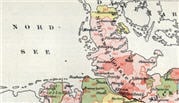Source Information
About Ludwigshafen, Germany, Family Tables, 1730-1903
About this collection
This collection contains alphabetical reference tables to birth, marriage and death records from Ludwigshafen beginning in 1851 as well as some records beginning in 1730 for formerly independent communities that were later incorporated into Ludwigshafen. Ludwigshafen is situated on the left (west) bank of the Rhine opposite the city of Mannheim. It is located about 12 miles north of Speyer and about 15 miles north-west of Heidelberg in the Rhine-Neckar region in the German state of Rhineland-Palatinate. Ludwigshafen is one of the independent cities in the state of Rhineland-Palatinate which was established in 1946.
Ludwigshafen, named in honor of King Ludwig I of Bavaria, became a municipality in 1852 and was elevated in 1859 to the status of "independent city." Since 1882 it has been officially known as "Ludwigshafen on the Rhine." During the time period of this collection, the communities that now compose Ludwigshafen belonged to the French Republic until 1816 and thereafter to the Kingdom of Bavaria. The collection includes records from the communities of Edigheim, Friesenheim, Maudach, Mundenheim, Oggersheim, Oppau, Rheingönheim and Ruchheim. The time period covered for each varies.
Beginning on May 1, 1798, birth, marriage and death records in left-bank areas, including the city of Ludwigshafen, followed the model of the French civil registry. Throughout the entire former German Empire, civil registration was taken over and performed by local registry offices beginning in January 1, 1876.
In addition to the civil records, registrars created alphabetical reference tables and directories (called family tables or books). In this case the forms were handwritten. The tables are arranged alphabetically by last name and chronologically by the first letter. For most communities, birth, marriage and death information is combined. Occasionally, marriage banns are also documented.
What you can find in the records
Depending on the form used, the following details may be found:
- Last Name and Given Names of the subject person
- Event Date (Year, Month, Day)
- Type of Event
- Cross-references to birth, marriage and death registers
- Notes
More about using this collection
Under "Browse this collection,” select the Civil Registration Office and then the desired Year Range and Volume.
 Need help with the German language? Find resources in our German Research Center.
Need help with the German language? Find resources in our German Research Center.